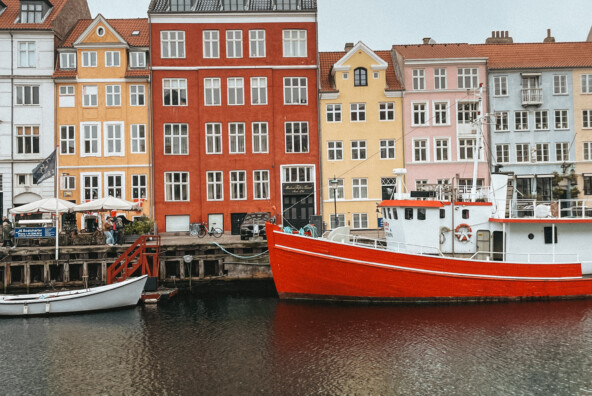We may receive a portion of sales if you purchase a product through a link in this article.
There’s a time and a place for roller luggage, but when it comes to short two- to three-day getaways, the best weekender bags are the ultimate travel companion. These handy, oversized duffels are large enough to pack a few days’ worth of clothing along with travel necessities like shoes, toiletries, electronics, and any other essentials you’ll need for a long weekend away.
Ahead, you’ll find the most functional and stylish weekender bags for your travels. Some include smart secret pockets for protecting your valuables or separate compartments for storing your shoes, while others will comfortably slide into your rolling suitcase for stress-free airport adventures. With any of these on hand, you’ll be looking for excuses to go on a mini escape every weekend.

Our Top Picks
- Our Team Favorite: Beis The Weekend Travel Bag — $108 at Nordstrom
- Best Basic Weekender Bag: Signature Weekender Bag — $79.99 at Target
- Best Extra Large Weekender Bag: Lambert The June Oyster Vegan Leather Travel Bag — $214.99 at Lambert
- Best Small Weekender Bag: CALPAK Luka Duffle Bag — $128 at Nordstrom
- Best Duffel: Dagne Dover Landon Large Neoprene Carryall — $215 at Nordstrom
1. Our Team Favorite: Beis The Weekend Travel Bag

Anytime the Camille Styles team is traveling, we all use the iconic Beis Weekender. It may just be the most popular overnight bag of all time, thanks to its smart, oversized design. Camille Styles producer, Michelle has had hers for years and receives compliments everywhere she goes. She absolutely loves the leather construction and well-designed pockets, like the large zippered pocket that’s able to fit curated outfits, accessories, and work essentials (including your laptop!), plus a separate bottom compartment that’s specifically designed to store your shoes and toiletries.
It can get pretty heavy considering how roomy the bag is, but it makes for an exceptional carry-on or personal item because of the handy luggage sleeve, especially given the not-too-lofty price tag.
2. Best Basic Weekender Bag: Signature Weekender Bag

Contrary to popular belief, you don’t need to drop major moolah to find a well-made, reliable weekender. This one from Target rivals the space of our all-round pick, and the variety of use cases make it well worth the (incredible) price. Plus, beyond the roomy main compartment and padded laptop space, it also includes additional tiny pockets that keep important items like your passport and keys within reach.
You can also carry this in a variety of ways. The easy-to-grip handles fit nicely into your hands, the padded strap allows you to sling it over your shoulder, or you can rest it comfortably on your suitcase thanks to the handy luggage sleeve, all under $100.
3. Best Extra Large Weekender Bag: Lambert The June Oyster Vegan Leather Travel Bag

If you tend to overpack (we’ve all been there!), don’t stress yourself out by trying to cram everything into a small bag. With the extra large Lambert weekender bag, you’ll be able to fit that fifth outfit (plus your laptop, toiletries, and accessories) with room to spare. Camille Styles Managing Editor, Isabelle adores the chic vegan leather design—which scores her countless compliments in the TSA line—because it feels incredibly luxe and features well-thought-out interior pockets. The jumbo size offers more than enough room for longer trips, so you’ll surely get a ton of use out of it.
4. Best Small Weekender Bag: Calpak Luka Duffle Bag

If you’re skipping away for a quick one- or two-night getaway, a compact tote is perfect for fitting all of your necessities. The CALPAK Luka bag fits the bill and reminds me of a marshmallow-y Mary Poppins’ bag, thanks to the trendy-yet-durable soft shell exterior. You can fit a surprising number of items inside even though it’s one of the smallest picks on this list at 16 inches wide.
And as for the pièce de résistance? An external shoe pocket that keeps your kicks separate from the rest of your belongings, whether you use this as a gym bag or a travel companion.
5. Best Duffel: Dagne Dover Landon Large Neoprene Carryall

People constantly rave about the Dagne Dover backpack, and the brand’s Landon Carryall deserves just as much hype. This sleeper hit makes for a stylish gym or overnight bag because of the soft, expandable neoprene fabric and unexpected design features. Along with a standard laptop pocket, it also has a stretch key leash, a mesh bag for easy organization, a laundry bag, and two large compartments for handy water bottle storage.
6. Best Expandable Weekender Bag: Longchamp Le Pliage Original Expandable Travel Bag

Longchamp always delivers accessible designer bags, including expandable weekenders like this leather-trimmed option. The unique origami-inspired design expands or minimizes with just a zip, making the bag deeper or shallower depending on what your current needs are. Plus, when it comes to storing, you can fold it up teeny tiny to make room for other larger items.
7. Most Versatile: MZ Wallace Nik Duffle Bag

While weekender bags are the ultimate travel sidekick, the best ones can be used for a range of needs—whether it be a gym bag, work tote, or even your everyday carryall. The size and functionality of this MZ Wallace bag have made it a staple for young professionals and jet-setters alike, and it just may become your most used bag. With a padded nylon exterior, this design is completely water-resistant to defend against the elements.
You can also pack an impressive amount inside thanks to nine (!) interior pockets (including a special laptop compartment) and seven exterior pouches. You can say bye-bye to endlessly searching for your wallet or that one pair of sunnies that you swore you packed.
8. Most Comfortable Straps: Aota Weekender Bag

The straps on weekender bags can make or break their entire functionality. Think about it: These totes can get very heavy very quickly, and you won’t always have roller luggage to rest it on. To spare you from aching shoulders or hands, opt for this Aota bag. The soft leather handles boast an ergonomic fit, while the long shoulder strap comfortably fits in the nook of your shoulder so you can lug your items around without breaking a sweat. Plus, it doesn’t hurt that the bag comes in a gorgeous faux leather finish that’s comparable to the real thing.
9. Best Lightweight: Herschel Supply Co. Maia Weekender

Lightweight bags have their advantages—mainly, they’re so much easier to tote around. The Maia Weekender feels light as air with nothing in it and somehow maintains that same feel even when packed to the brim, likely because of the twill fabric. But this bag has so much more going for it than its lightweight nature. Sure, it’s affordable, but it also looks sleek with its leather trim, has snap-down extensions to easily store more items, and is designed with a variety of internal pockets for supreme organization.
10. Best Vegan Leather: Mali + Lili Riley Vegan Leather Weekend Travel Bag

Some vegan leather looks cheap and plastic-y, but that’s not the case with this Mali & Lili bag. The PETA-certified vegan leather is strikingly similar to the real thing, and most people won’t be able to tell the difference, even if they get really close. Looks aside, the stylish bag features a roomy main compartment along with a separate bottom one for shoe storage. Cute detailing, like the included luggage tag and swappable shoulder straps, pumps up the personality for a customizable flair.
11. Best Budget: Signature Athleisure Soft Puff Weekender Bag

Weekender bags aren’t always the most affordable items, but that doesn’t mean there aren’t any diamonds in the rough. Target always comes through with stylish, cost-effective options, including this design. While the unstructured bag doesn’t have any of the bells and whistles of some of its pricier counterparts, it gets the job done with a spacious main pocket, a few zippered compartments for storing valuables, and an adjustable carrying strap for comfortable maneuvering.
12. Best Machine Washable: Vera Bradley Women’s Microfiber Grand Weekender Travel Bag

If you’re someone who has written off Vera Bradley bags because of the loud patterns, one look at this Microfiber Grand Weekender will have you reconsidering your stance. The signature Vera Bradley print is reserved for the inside of the tote. From the outside, it seems like your run-of-the-mill travel bag with exterior pockets, a luggage sleeve, and a shoulder strap. There’s one minor detail that gives this bag the advantage over the sea of others, though: It’s machine washable, so when you need to spiff it up between trips, you can throw it in and forget about it.
13. Most Stylish: Badgley Mischka Juliet Travel Weekend Bag

Fake the look of a bespoke Italian leather bag with this gorgeous Badgley Mischka weekender. Inspired by high-end equestrian styles, the stylish tote features faux leather detailing with smart pockets, gold hardware, and comfortable straps. The spacious interior can hold quite a bit—up to 35 pounds, which is more than enough for multiple days’ worth of clothing and shoes. Choose between an off-white hue with tan leather accents or opt for the sleek all-black bag.
14. Best Compartments: Away The Weekender

One of the most frustrating aspects of deep weekender bags is having to dig for the exact item you’re looking for, so you end up taking everything out to grab that one favorite blouse. Away created a genius solution to this dilemma with its clam shell-zipper duffel that sprawls open in front of you, offering a clear view of each item you’ve packed.
The separate compartments also help you curate expert-level organization: Smaller zippered pockets are perfect for storing electronics, jewelry, and some toiletries, while the outer padded laptop pocket keeps your device secure with strong magnetic closure. As a bonus, it’s available in a few neutral colors, but you can even personalize it with your initials for an extra $35.
15. Best Leather Weekender Bag: Quince Italian Leather Triple Compartment Weekender

If you want genuine leather, get ready to spend some major money for a quality weekender bag—that is, unless you shop at Quince. The brand takes out the middleman to bring you equitable, quality fashions at lesser prices. The brand’s leather weekender, for instance, is crafted with 100% top-grain Italian leather and is seriously gorgeous. Aside from the looks, the bag is extremely functional, with three zippered compartments, metal feet to prevent scuffs, a removable shoulder strap, and a luggage sleeve.
16. Best Weekender Bag with Luggage Strap: The ReNew Transit Weekender

I never realized how important a luggage strap was until I owned a bag that continuously slid off my suitcase. (Yes, it was beyond aggravating!) Not all luggage straps are created equal, but the one on Everlane’s ReNew Weekender is levels above other options. Besides firmly hugging your suitcase handle, it also doubles as a secret pocket for storing items that you want to keep on hand.
When you’re not traveling with a suitcase, this lightweight bag isn’t a pain to tote around because of the sturdy handles and adjustable over-the-shoulder strap. Some other added perks? It’s made from 100% recycled polyester from recycled plastic bottles and comes in four different colors: black, cream, gray, and olive green.
17. Best Water-Resistant Weekender Bag: Monos Metro Weekend Bag

Nothing is worse when you’re traveling than getting caught in a rainstorm and ending up with soggy luggage, which is why we had to include a waterproof bag on our list. This water-resistant weekender from Monos is guaranteed to keep your belongings completely dry, regardless of whether you opt for the nylon or vegan leather finish. It features a spacious main compartment with a separate laptop pocket and smaller pouches, while the zipper closure keeps the elements shielded from your stuff. If you do end up with wet items (you know, like sweaty workout clothes or soaked bikinis), you can pop them in the separate bottom compartment, which is also an excellent spot to pack shoes.
18. Best Personal Item: July Carry All Weekender

Some weekenders are entirely too big to meet the personal item requirements on some airlines, but that’s not the case for this pick from July. The sleek, briefcase-esque duffel measures in at 10.5- by 18- by 8.5 inches, so it can comfortably fit under the seat on most commercial jets. It also fits much more than your office essentials: Functional design elements, like the large main compartment, laptop pocket, and hidden external pocket, offer enough room for a few days worth of outfits and toiletries without feeling like you have to cram it to the brim. Not to mention, you’ll feel effortlessly chic carrying it around, thanks to the elegant look.
19. Best Splurge: Rothy’s The Weekender

There are endless rationales for splurging on the Rothy’s weekender, and at the top of the list is the bag’s care. It can be thrown in the wash when it needs sprucing up (a rare quality in structured weekender bags). The versatility makes it a no-brainer for any trip with three massive zippered compartments (including a special slot for your laptop). It can store boundless clothing and accessories while the padded straps ensure carrying the tote is painless, all while still fitting in the overhead compartment on most major airlines. This is also a purchase you can feel good about: Rather than being constructed of nylon or leather, the bag is made from recycled marine plastic.
Related Posts
Spring Blooms Are Here—Here Are The 10 Best Places to Find Vases Online
Easy, but impactful.
6 Handbag Trends That Are Dominating Spring Fashion
Our style editor shares how to style them.
Prices were accurate at the time of publication.










